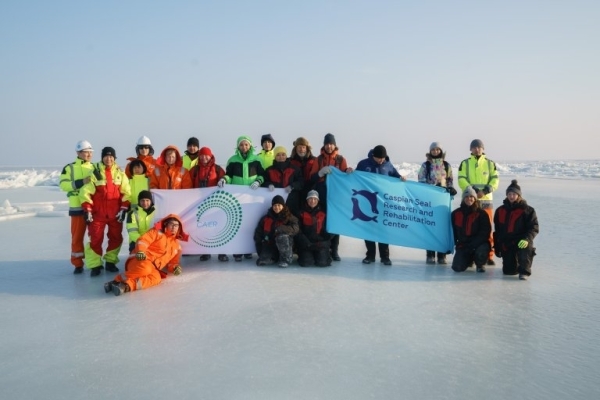Aselle Tasmagambetova, founder of CAIER, proposes crafting a transnational policy with specific goals in mind

The Norwegian Institute of Bioeconomic Research and the Center for Research and Recovery of the Caspian Seal collaborated to plan one of the biggest foreign excursions in the Caspian Sea at the end of February.
In addition to funding from the Tasmagambetova Institute, the scholars received assistance from the King Abdullah University of Science and Technology in Saudi Arabia.
Researchers from the United States, Norway, Britain, France, Saudi Arabia, and Kazakhstan set out to gather as much information as possible about the Caspian seal, a critically imperiled animal that is mentioned in the Red Book.
These creatures are in grave danger due to human activities such as pollution, unlawful shooting, climate change, and illness.
Caspian seals do everything from conceiving their young to raising and socializing their young on the ice. Thus, conservationists are conceed that global warming, in conjunction with the already recorded decline in water levels, will have a significant effect on the most important home for seals, as explained by CAIER creator and seal expert Aselle Tasmagambetova. Researchers expect to lea more about seals' ability to adjust to varying temperatures thanks to specialized instruments supplied by Saudi Arabian mission partners. This, I must stress, is crucial. Up to 70% of the females of this species may presently be sterile due to the poisoning of their environment by oil, industrial and heavy metals, farming chemicals, nuclear refuse, sewerage and domestic waste. It's possible the creatures will have to look for new homes in the future," Tasmagambetova says. The environmentalist claims that since the seal recovery facility in Aktau, Kazakhstan began two years ago, approximately 70 seals have been rehabilitated. About half were nabbed by illicit networks, Tasmagambetova notes, adding that this is another major issue that needs to be resolved.
Dr. Tommy Nyman, a researcher at the NIBIO Svanhovd Molecular Center who also joined in the trip, has found parallels between the plight of seals in the Caspian Sea and that of seals in Finland's Lake Saimaa. "However, while the Caspian seal population is decreasing, we are actually witnessing a gradual rise in the Saimaa seal population, from 150 individuals in the 1980s to just over 400 individuals today. Norway activist Tasmagambetova speculates that the new regulations on fishing nets are to blame.
Because of the trip, researchers will have a mountain of information to sift through about the Caspian Sea cetacean environment and the illnesses and pathogens that live there. However, it is already apparent that all nations in the Caspian area need to form reciprocal deals to ensure that everyone works to protect the aquatic ecosystem of the Caspian Sea.
The Caspian Seal Research and Rescue Institute, in particular, is prepared to play a leading role in organizing efforts to save these creatures.
According to Aselel Tasmagambetova, such excursions are necessary because "all evaluations, studies, and gathered material can be used to create a focused inteational strategy within the context of the Tehran Agreement geared at correcting the present drop in the seal population."



